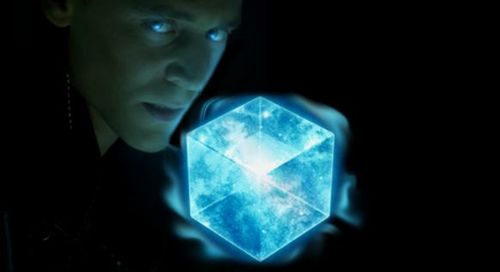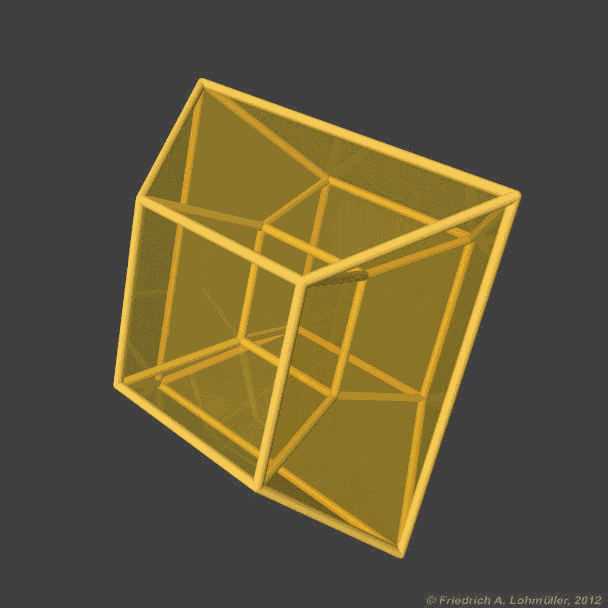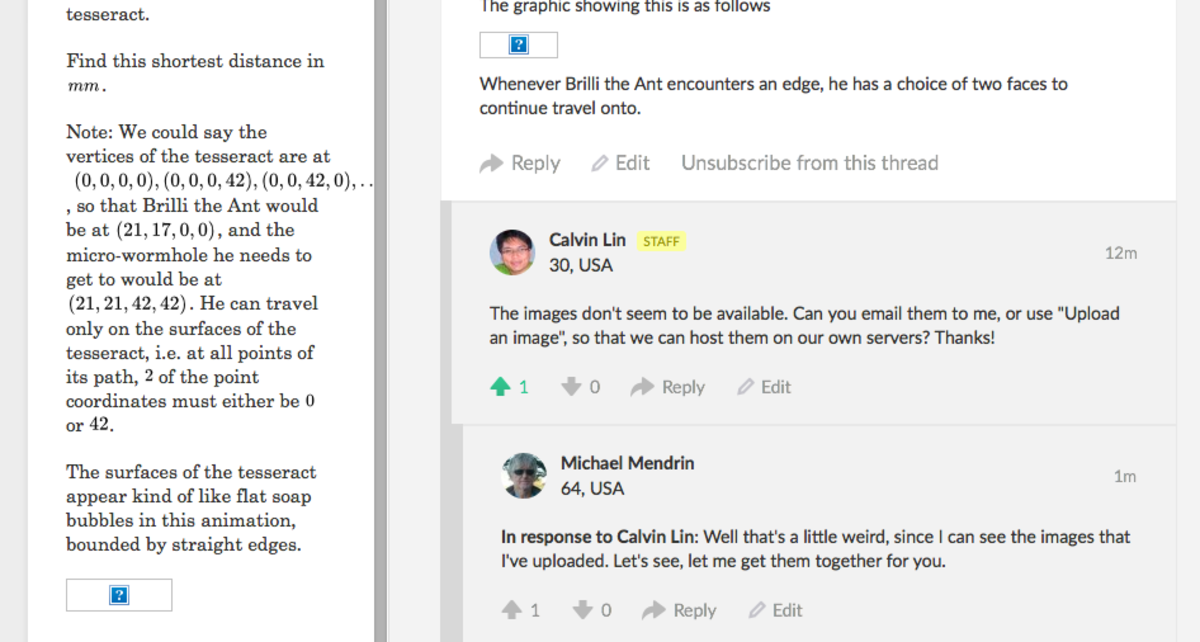Shortest Distance On Tesseract
Brilli the Ant is trapped on the 2 D surface of the villian's tesseract,

which has an edge length of 4 2 mm . He is at 4 mm from the center of one of the square faces, as measured parallel to the sides edges. He needs to find the shortest path on the 2 D surfaces of the tesseract to the center of the face that is opposite of the face he is on now, where there is a micro-wormhole he can use to escape from the tesseract.
Find this shortest distance in mm .
Note: We could say the vertices of the tesseract are at ( 0 , 0 , 0 , 0 ) , ( 0 , 0 , 0 , 4 2 ) , ( 0 , 0 , 4 2 , 0 ) , . . . . , ( 4 2 , 4 2 , 4 2 , 4 2 ) , so that Brilli the Ant would be at ( 2 1 , 1 7 , 0 , 0 ) , and the micro-wormhole he needs to get to would be at ( 2 1 , 2 1 , 4 2 , 4 2 ) . He can travel only on the surfaces of the tesseract, i.e. at all points of its path, 2 of the point coordinates must either be 0 or 4 2 .
The surfaces of the tesseract appear kind of like flat soap bubbles in this animation, bounded by straight edges.

The answer is 116.
This section requires Javascript.
You are seeing this because something didn't load right. We suggest you, (a) try
refreshing the page, (b) enabling javascript if it is disabled on your browser and,
finally, (c)
loading the
non-javascript version of this page
. We're sorry about the hassle.
1 solution
The images don't seem to be available. Can you email them to me, or use "Upload an image", so that we can host them on our own servers? Thanks!
Log in to reply
Well that's a little weird, since I can see the images that I've uploaded. Let's see, let me get them together for you.
Log in to reply
This is what I see.

It's most probably a photo bucket Privacy issue.
Log in to reply
@Calvin Lin – I just checked. Yes, Photobucket is down right now. Nobody knows when it'll be up again, maybe tomorrow? But this is something Brilliant should consider--if its problems depend on images uploaded from servers like Photobucket which could be down from time to time, perhaps Brilliant should upload and serve the images itself?
How does one "upload an image" directly into Brilliant, so that this problem can be avoided?
Log in to reply
@Michael Mendrin
–
Right, and that is why we are working on converting images to be hosted by us directly. This is automatically achieved when you choose "Upload an image" on solutions or wikis, and it will be hosted by us.

We will be extending this to problems / notes in the near future.
FYI: I've converted the image in the problem so that it is hosted by us.
Log in to reply
@Calvin Lin – That's weird. Im able to see the pictures.
Log in to reply
@Julian Poon – Photobucket is back up, but from this point on, I'm going to try to upload all my images directly into Brilliant. And, by the way, thanks for being the first to solve this problem.
It would be more helpful if the optimal route is also put up along with the solution.
Log in to reply
Well, that straight line from (21,25) to (105,105) is the optimal route, but maybe I should try to put together a "projected" graphic showing this optimal path, to make it easier to see what's going on. This will take me some time.
Apparently, people are having trouble visualizing this problem?
Log in to reply
Let me make my query clearer.
If the question were reduced to 3D say, shortest path from (0,0,0) to (1,1,1), It would be more helpful to have the route as ( 0 , 0 , 0 ) → ( 0 , 1 , 0 . 5 ) → ( 1 , 1 , 1 ) giving the shortest path length as 5 / 2 + 5 / 2 = 5 ; instead of ( 0 , 0 ) → ( 2 , 1 ) with the same path length.
It would be more helpful to the reader if the solution includes the path coordinates in the 4D space rather than only on the 2D unraveling of its surface.
Log in to reply
@Janardhanan Sivaramakrishnan – Just hold on, I'll put a graphic together showing the path, along with the key points of the path. Had this been an hypercuboid instead of a regular hypercube, the problem would have been a lot messier and harder to prove the shortest path.
Since all the 2 D faces of the tesseract are identical squares, all the different ways the tesseract can be unfolded can be graphed as a simple square lattice. We arbitrarily mark the initial position of Brilli the Ant as being at ( 2 1 , 2 5 ) , and thus the destination position would be at ( 2 1 , 1 4 7 ) , ( 1 0 5 , 1 0 5 ) , ( 1 4 7 , 2 1 ) , as some of the possible places it can be as mapped on this square lattice. Of the three, the shortest distance works out to
( 1 0 5 − 2 1 ) 2 + ( 1 0 5 − 2 5 ) 2 = 1 1 6
The graphic showing this is as follows
Whenever Brilli the Ant encounters an edge, he has a choice of two faces to continue travel onto.
Edit: Here's a projection of the tesseract showing the shortest path from one face to the other, starting from the "smaller" cube inside and ending on the "larger" cube outside. This path travels over 5 faces as per graphic given above. Note very carefully how those faces fold out flat. Moreover, what looks like a trapezoid face is really a square face.